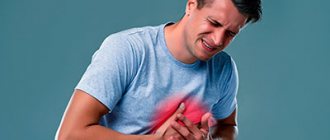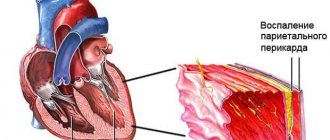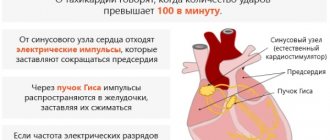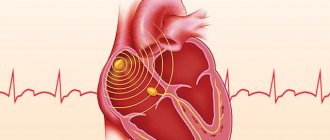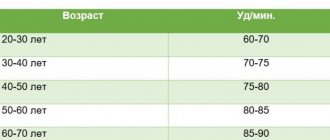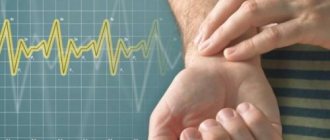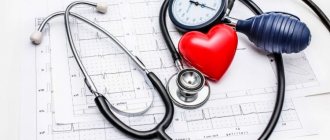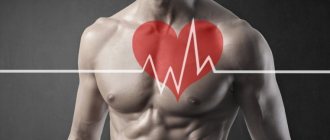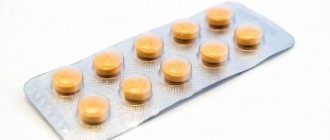A heart rate (HR) of more than 90 beats/min is considered elevated. in a minute. It can be like this in normal conditions and in pathologies. If the heart rate is increased in a healthy person, the reason for this is increased air temperature, high physical activity or emotional overload.
But the heartbeat often accelerates in pathologies. Among them are diseases of the cardiovascular, endocrine, respiratory, nervous systems, as well as infectious diseases. In these cases, patients require immediate medical attention to relieve stress on the heart muscle.
What is cardiac tachycardia?
A healthy heart works in a constant rhythm, and normally a person does not feel its beating.
But if the normal heartbeat is disrupted, discomfort in the chest, anxiety, dizziness and pulsation in the area of large vessels appear. During the cardiac cycle, i.e. rhythmic contraction and relaxation of the heart muscle, the vessels are first filled with blood, and then their blood supply decreases. The vibration of the vascular walls during this cycle is called the pulse. Normally, the heart beats 60-90 times per minute. If the heart rate is more than 90 beats per minute, it is tachycardia, less than 60 is bradycardia.
How to measure pulse?
It is recommended to measure your pulse in the morning immediately after waking up in a lying position. It is better to do this on the wrist, feeling the artery with the middle and index fingers. You need to count the number of hits in 15 seconds and multiply the indicator by 4.
The heart rate in healthy people depends on many factors:
- gender: on average, women's heart beats slightly faster than men's;
- age: with age, the pulse gradually slows down, but after 50-55 years it increases again, especially in women with the onset of menopause;
- environment: poor environmental conditions affect heart rate;
- time of day: during night sleep the pulse slows down, and at 11 o’clock in the day it accelerates to maximum values;
- lifestyle: tachycardia is observed in people who smoke, as well as in people who regularly drink alcohol, with improper work and rest schedules, and lack of sleep;
- Diet: Some foods and drinks, as well as medications, speed up your heart rate.
An increase in heart rate can be observed in a completely healthy person after active sports, heavy physical work, with a lack of oxygen, heat, during stressful situations, after drinking a large amount of strong coffee or alcohol (Fig. 1). The heart beats faster in response to external factors. In this case, tachycardia is a reaction to the release of adrenaline into the blood or nervous excitement. Usually the pulse returns to normal after a fairly short rest.
Figure 1. How coffee and alcohol affect heart rate. Source: MedPortal
Another manifestation of the protective function of tachycardia is a rapid pulse in patients with internal bleeding or significant blood loss due to injury. An increase in heart rate allows you to avoid hypoxia and saturate the myocardium with oxygen in conditions of decreased hemoglobin levels in the blood.
Children's pulse
In children, the heart rate is noticeably different, since the growing body has a high need for oxygen and nutrients. An accelerated metabolism leads to an increased heart rate at rest. In newborns, the heart beats at a frequency of 120-140 beats per minute, the most frequent pulse in six-month-old babies is 130-135. With age, the heart rate gradually slows down, and in 15-year-old teenagers it is already approaching the norm for adults.
Symptoms
Oddly enough, an increase in heart rate of more than 140 per minute that occurs suddenly is usually well tolerated by patients. Such an attack can even last for several days, and the patient does not notice it or only feels weakness that is incomprehensible to him.
The more the heart muscle is affected and the more severe the heart disease, the more signs appear during an attack of tachycardia:
- chest pain;
- shortness of breath, lack of air, especially when lying down;
- sweating, severe weakness;
- dizziness, clouding of consciousness;
- fainting, loss of consciousness.
In the most severe cases, there is a risk of developing a stroke.
Causes
The causes of pathological tachycardia are divided into cardiac ones, i.e. associated with dysfunctions of the cardiovascular system, and extracardiac - caused by diseases of other organs and systems of the body.
Extracardiac causes:
- physical inactivity,
- heat,
- diseases of the endocrine system - hyperfunction of the thyroid gland, low blood sugar,
- anemia - drop in hemoglobin level,
- low blood pressure,
- chronic bronchitis, bronchial asthma, pneumonia,
- states of shock,
- adrenal tumors,
- lack of weight, strict diets,
- intoxication with certain drugs,
- problems with the nervous system,
- abdominal obesity,
- apnea,
- some diseases of internal organs.
Heart pathologies:
- myocardial infarction and its complications,
- hypertonic disease,
- cardiomyopathy,
- various congenital and acquired heart defects.
Risk factors for developing tachycardia:
- diabetes mellitus and thyroid diseases;
- alcoholism;
- genetic predisposition;
- high blood pressure;
- elderly age.
Tachycardia in pregnant women
An increase in heart rate of 20-30 beats per minute often occurs in women at different stages of pregnancy. This may be due to:
- hormonal changes;
- an increase in the amount of circulating blood;
- pressure from the enlarged uterus on the heart and blood vessels.
In the absence of a history of heart disease, this condition is considered normal and goes away after childbirth. Women with excess weight, endocrine and cardiovascular diseases, and bronchial asthma require increased attention.
How to measure your pulse?
If you want to measure your pulse, then its frequency can be detected at the temples, neck, and in the area of the heart. However, it is most convenient to do this on the wrist. To do this, you need to try to find with two fingers of your right hand the main artery where the pulse can best be felt. It is very important to do this with any fingers except the thumb. The fact is that the thumb has its own pulse, and it will prevent you from measuring the rhythm of the heartbeat.
You need to measure the number of beats for 10 seconds, multiply the result by 6. You will get the average heart rate. All that remains is to compare it with the norm. If a high pulse is detected for which there is no reason, then you need to try to bring it down.
Classification of tachycardia
The classification of tachycardia is based on determining the primary sources of rapid heart rate.
Sinus tachycardia
This type of tachycardia is diagnosed when the heart rate is in the range of 100-200 beats per minute. This disorder is a physiological response to irritation of the sympathetic nervous system: stress, physical activity, pain, etc.
Sinus tachycardia is characterized by a gradual onset and smooth normalization of the pulse. A prolonged attack can cause dizziness, decreased blood pressure, and a decrease in the amount of urine produced.
This is the most common type of tachycardia and does not require special treatment. In most cases, the heart rate returns to normal after the cause of the increased heart rate is eliminated.
Ventricular tachycardia
The pathology is based on an increase in the number of contractions of the ventricles and acceleration of the heart rate due to disturbances in the structure of the myocardium or the conduction system of the ventricles. As a result, the electrical impulse is interrupted in the ventricles and circulates in a vicious circle.
The pulse during an attack of ventricular tachycardia increases to 140-220 beats per minute, which can lead to disruption of blood supply to the brain, a sharp drop in blood pressure and loss of consciousness.
This is the most dangerous type of tachycardia and can lead to ventricular fibrillation, a condition in which the heart can beat more than 300 times per minute.
Ventricular tachycardia can lead to circulatory arrest and clinical death.
In the vast majority of cases, the cause of ventricular arrhythmia is coronary heart disease. Sometimes an attack occurs while taking certain medications: cardiac glycosides, psychotropic drugs, anesthetics.
Atrial tachycardia
This type of tachycardia develops in limited areas of the atria. In the general structure of arrhythmias, atrial tachycardias account for 10-15% of cases.
Risk factors for atrial tachycardia:
- hypertonic disease;
- cardiac ischemia;
- congenital and acquired heart defects;
- chronic bronchitis.
Atrial tachycardia can occur against the background of endocrine disorders, alcohol abuse, and obesity.
Atrioventricular tachycardia
This type of arrhythmia is not associated with pathologies and is more common in adolescents and young adults during physical and emotional stress. In adults, rapid heartbeat appears against the background of heart disease and sclerotic changes in the heart muscle.
Paroxysmal tachycardia
This type of arrhythmia is characterized by attacks of rapid heartbeat with a frequency of up to 220 beats per minute and above. Various forms of paroxysmal tachycardia are diagnosed in 20-30% of patients with arrhythmia.
Normally, electrical impulses are generated in the sinus node, the natural pacemaker of the heart muscle. In paroxysmal tachycardia, they are generated in the ventricles, atria or atrioventricular junction. The attacks begin suddenly and end just as abruptly, repeating regularly at approximately equal intervals.
Attacks of paroxysmal tachycardia impede blood circulation, and the heart works with increased load. Prolonged attacks lead to weakness and fainting.
Arterial tachycardia
Tachycardia of this type is not a separate form of heart rhythm disturbance; it is considered as a symptom of various pathologies. Most often, arterial tachycardia is associated with hypertension and other vascular diseases. Usually detected in older people.
With hypertension, rapid heartbeat is accompanied by shortness of breath, tinnitus, dizziness, and general weakness. A person may not feel a strong pulsation, and a heart rate above 100 beats per minute is determined only by a doctor when measuring blood pressure if a hypertensive crisis is suspected.
Orthostatic tachycardia
With a steady acceleration of the pulse (more than 30 beats per minute in adults and 40 beats in children) when changing from a lying position to a standing position, they speak of orthostatic tachycardia syndrome. This condition is not a separate disease; this term refers to a large number of characteristic symptoms. Treatment is required only for regular attacks accompanied by nausea, dizziness and chest discomfort.
Symptoms of the disorder
Depending on the symptoms and characteristics, three types of tachycardia are distinguished:
- sinus (nodular);
- supraventricular;
- ventricular
A pulse of 150 indicates the presence of sinus or supraventricular tachycardia.
Sinus tachycardia
The main symptoms of the disorder are:
- strong heartbeat is accompanied by pain (a feeling of squeezing) in the chest;
- fainting;
- feeling of weakness;
- panic attack (feeling of fear for your life);
- severe lack of air;
- blurred vision.
Why is tachycardia dangerous?
Tachycardia poses a health hazard if it is caused by dysfunction of the cardiovascular system or other diseases of the internal organs. A rapid heartbeat prevents the heart ventricles from filling with blood, which leads to a decrease in blood pressure and a deterioration in the blood supply to internal organs. In addition, a heart working hard requires much more oxygen. This condition threatens to develop into acute heart failure and lead to heart attack and coronary artery disease.
Why is the pulse higher than normal?
The causes of increased heart rate can be caused not only by internal factors, but also by external ones:
- You have recently experienced severe stress or nervous tension.
- The pulse increases during periods of intense physical activity.
- You ate more than normal.
- A constantly high heart rate may occur if you are overweight.
- You've been on your feet all day (tired).
- Presence of heart disease.
- Taking certain medications can also cause your heart rate to increase.
- The body does not have enough vitamins belonging to group B.
- A sharp surge of adrenaline.
- Pregnancy. During this period, it is completely normal that the pulse rate of the fair sex is higher than usual.
Diagnostics
The main method for diagnosing tachycardia is an electrocardiogram. Based on the nature of the ECG, the doctor determines the type of pathology and the degree of its severity (Fig. 3).
Figure 3. ECG picture in the presence of tachycardia. Source: MedPortal
To clarify the main diagnosis, daily Holter ECG monitoring, cardiac MRI, echocardiography and other hardware and laboratory tests are prescribed.
Treatment
Treatment is aimed at eliminating the causes of rapid heartbeat and is carried out comprehensively. First of all, factors that cause tachycardia are excluded: it is forbidden to drink strong coffee, tea, alcoholic beverages, eat chocolate, or smoke. It is recommended to normalize your emotional state and avoid excessive physical activity.
The complex of treatment of the underlying disease includes sedatives and additional drugs that normalize the functioning of the heart muscle.
Photo: v_l / freepik.com
If tachycardia is caused by structural changes in the heart or a disruption in the production of hormones and does not respond to drug treatment, the patient may be offered surgery: radiofrequency catheter ablation, installation of a pacemaker, removal of tumors if present. In any case, the treatment regimen is prescribed by a cardiologist after consultation with other specialists.
Important! Medicines that correct heart rhythm should not be taken without a doctor’s prescription; incorrect selection of therapy can only worsen the disease.
Drug reduction of heart rate
It is not at all necessary to go to the hospital immediately as soon as you notice a rapid heartbeat. You can try to normalize it at home yourself using medications that can be purchased at a pharmacy without a prescription from your doctor.
What to take if your heart rate is high:
- valerian in any form;
- "Valocordin";
- motherwort tincture;
- "Validol".
When taking any of the drugs listed above, it is important to understand the fact that they will only eliminate the symptoms of tachycardia, but not the cause of its occurrence. That is why you will still need to see a doctor when you feel better. Don't expect medications to work right away. If the effect is not felt within 10-15 minutes, there is no need to take another dose. This may cause your heart rate to slow down too much. The main thing is to remember that you need to take any drug only if you have a high pulse, the reasons and explanations for which you cannot find.
Prognosis and prevention
If you follow all medical recommendations and switch to a healthy lifestyle, the prognosis is favorable. The success of therapy depends on the time of contacting a doctor and the adequacy of treatment of the underlying disease.
In order to reduce the risk of developing tachycardia, you should:
- eat varied and regularly, include vegetables, fruits, fish, dairy and seafood in your diet,
- regularly do exercises, cardio exercises,
- avoid stress,
- do not abuse coffee and alcohol, stop smoking.
Photo: DCStudio / freepik.com
Therapeutic measures
The disease is always better and easier to prevent. But if it does affect the body, it is necessary to provide adequate first aid to a patient with tachycardia. A number of potent medications are used for this. In the future, such patients are prescribed a special drug regimen for lifelong use.
Preventive measures
In order to prevent a pathological increase in heart rate, the patient must adhere to the following rules:
- Lead a healthy lifestyle. Quitting smoking and alcohol and substance abuse will help reduce the risk of tachycardia.
Avoid excessive stress. To do this, you need to study mental hygiene and try to adhere to all its rules.- Attend diagnostic examinations regularly. This is especially true for patients at risk who are prone to atherosclerotic vascular damage and have a high concentration of low-density lipoproteins in the blood.
- Engage in moderate physical labor. Exercise within reasonable limits is beneficial for the body, as it stimulates cells and tissues to renew themselves.
First aid
Faced with an increase in heart rate, a person asks the question: what to do in such a situation, how to help yourself or a loved one? First of all, the patient needs to calm down. To do this, he must take a sitting or lying position and, if possible, seek help from others or call an ambulance. If tachycardia is accompanied by chest pain, you should take a Nitroglycerin tablet.
To stop an attack of tachycardia, the treatment regimen includes the following drugs:
- antiarrhythmics Amiodarone, Cordarone;
- some calcium channel blockers: Verapamil, Amlodipine, Nifedipine;
- beta blockers: Propranolol, Bisoprolol, Atenolol and Carvedilol.
Sources
- Utsumueva M.D., Mironov N.Yu., Shlevkov N.B., Kiktev V.G., Gupalo E.M., Kashtanova S.Yu., Mironova N.A., Golitsyn S.P. Paroxysmal supraventricular tachycardia in a patient with dilated cardiomyopathy and concomitant cardiac conduction disorders. Clinical case and discussion of the problem. Cardiovascular therapy and prevention. 2020;19(3):2368.
- Salami Kh.F., Shlevkov N.B., Sokolov S.F. Possibilities and limitations of standard electrocardiography for the differential diagnosis of tachycardias with widened QRS complexes. Almanac of Clinical Medicine. 2019;47(4):350-360.
Rapid heartbeat: preventive measures
If you want to maintain your heart rate within normal limits, use the following preventive measures, they will significantly improve heart function:
- Avoid drinking soda, dark chocolate and coffee completely. Each of these products provokes a pulse higher than normal.
- Give up bad habits such as smoking and drinking alcohol - they definitely won’t make you healthier.
- Before using pharmaceutical drugs, carefully read the packaging to find out if they cause any side effects.
- If you are overweight, try to lose a few kilograms, then the load on your heart will be less.
- Moderate exercise will improve your overall health and heart function.
- Eat as many vegetables and fruits as possible, and eat fried, highly fatty or spicy foods as little as possible.
- Try to get proper rest. If you sleep 4-5 hours a day, then there is no question that you will feel good. If your heart rate is high, the reasons may be hidden in lack of sleep.
- Try to be nervous about trifles as little as possible; the release of adrenaline increases your heart rate.
